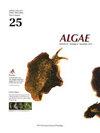Ultrastructural changes of Haematococcus pluvialis (Chlorophyta) in process of astaxanthin accumulation and cell damage under condition of high light with acetate
IF 2.4
3区 生物学
Q1 MARINE & FRESHWATER BIOLOGY
引用次数: 8
Abstract
Haematococcus pluvialis is a commercial microalga that can produce high quantities of astaxanthin. Under induced conditions, some important changes in the subcellular structures related to astaxanthin accumulation were observable. For example, a large number of astaxanthin granules, oil structures and starch granules appeared in the thick-walled cells; Astaxanthin granules gradually dissolved into the oil structures and spread throughout the entire cell with the fusion and diffusion process of oil structures during the middle and late stages of induction; The plastoglobules were closed to the newly formed structures, and some plastoglobules would abnormally increase in size under stress. Based on observations of cell damage, the degradation of membrane structures, such as chloroplasts, was found to be the primary form of damage during the early stage of induction. During the middle stage of induction, some transparent holes were exposed in the dissolving astaxanthin granules in the cytoplasm. In thick-walled cells, these transparent holes were covered by oil substances dissolving astaxanthin, thereby avoiding further damage to cells. Given the relatively few oil structures, in non-thick-walled cells, the transparent holes expanded to form multiple transparent areas, eventually resulting in the rupture and death of cells. These results suggested that the high level of synthesis and the wide range diffusion of oil explained the expansion of astaxanthin in H. pluvialis.雨生红球藻(绿藻)在乙酸盐强光下虾青素积累和细胞损伤过程中的超微结构变化
雨红球菌是一种可生产大量虾青素的商业微藻。在诱导条件下,观察到与虾青素积累有关的亚细胞结构发生了一些重要变化。如厚壁细胞中出现大量虾青素颗粒、油结构和淀粉颗粒;在诱导中后期,虾青素颗粒随着油结构的融合扩散过程逐渐溶解到油结构中,并扩散到整个细胞;微球与新形成的结构紧密相连,部分微球在应力作用下会异常增大。根据对细胞损伤的观察,发现膜结构(如叶绿体)的降解是诱导早期损伤的主要形式。在诱导中期,细胞质中溶解的虾青素颗粒暴露出一些透明的孔洞。在厚壁细胞中,这些透明孔被溶解虾青素的油类物质覆盖,从而避免了对细胞的进一步损害。由于油结构相对较少,在非厚壁细胞中,透明孔扩大形成多个透明区域,最终导致细胞破裂死亡。这些结果表明,高水平的合成和大范围的油扩散解释了虾青素在雨杉中的扩张。
本文章由计算机程序翻译,如有差异,请以英文原文为准。
求助全文
约1分钟内获得全文
求助全文
来源期刊

Algae
PLANT SCIENCES-
CiteScore
5.10
自引率
25.00%
发文量
18
期刊介绍:
ALGAE is published by the Korean Society of Phycology and provides prompt publication of original works on phycology. ALGAE publishes articles on all aspects of phylogenetics and taxonomy, ecology and population biology, physiology and biochemistry, cell and molecular biology, and biotechnology and applied phycology. Checklists or equivalent manu-scripts may be considered for publication only if they contribute original information on taxonomy (e.g., new combinations), ecology or biogeography of more than just local relevance. Contributions may take the form of Original Research Articles, Research Notes, Review Articles and Book Reviews.
 求助内容:
求助内容: 应助结果提醒方式:
应助结果提醒方式:


